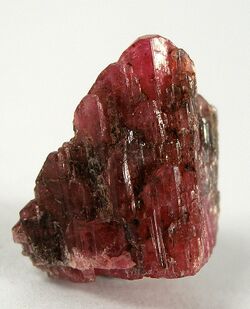Chemistry:Väyrynenite
From HandWiki
| Väyrynenite | |
|---|---|
 Väyrynenite (size: 1.7 x 1.4 x 0.6 cm) | |
| General | |
| Category | Phosphate mineral |
| Formula (repeating unit) | MnBe(PO4)(OH,F) |
| Strunz classification | 8.BA.05 |
| Crystal system | Monoclinic |
| Crystal class | Prismatic (2/m) (same H-M symbol) |
| Space group | P21/a |
| Unit cell | a = 5.411(5) Å, b = 14.49(2) Å, c = 4.73 Å; β = 102.75°; Z = 4 |
| Identification | |
| Color | Light pink to rose-red, salmon pink, pale gray, brown |
| Crystal habit | Rare as elongated and striated prismatic crystals; fine-grained aggregates |
| Cleavage | Perfect on {010}, good on {100}, fair on {001} |
| Fracture | Uneven |
| Tenacity | Brittle |
| Mohs scale hardness | 5 |
| |re|er}} | Vitreous |
| Streak | White |
| Diaphaneity | Transparent to translucent |
| Specific gravity | 3.22 |
| Optical properties | Biaxial (–) |
| Refractive index | nα = 1.638 - 1.640 nβ = 1.658 - 1.662 nγ = 1.664 - 1.667 |
| Birefringence | δ = 0.026 - 0.027 |
| Pleochroism | Visible X= orangish, Y= red, Z= dark red |
| 2V angle | 46°–55° |
| Dispersion | r > v moderate |
| References | [1][2][3] |
Väyrynenite is a rare phosphate mineral with formula MnBe(PO4)(OH,F).[1] It was first described in 1954 for an occurrence in Viitaniemi, Erajarvi, Finland and named for mineralogist Heikki Allan Väyrynen of Helsinki, Finland.[3]
It occurs in pegmatites as an alteration of beryl and triphylite. It occurs in association with eosphorite, moraesite, hurlbutite, beryllonite, amblygonite, apatite, tourmaline, topaz, muscovite, microcline and quartz.[3]
References
- ↑ 1.0 1.1 Väyrynenite on Mindat.org
- ↑ Väyrynenite data on Webmineral
- ↑ 3.0 3.1 3.2 Väyrynenite data from the Handbook of Mineralogy
- ↑ Warr, L.N. (2021). "IMA–CNMNC approved mineral symbols". Mineralogical Magazine 85 (3): 291–320. doi:10.1180/mgm.2021.43. Bibcode: 2021MinM...85..291W.
 |

